|
 indicates that the locomotive is equipped with a DCC sound decoder. indicates that the locomotive is equipped with a DCC sound decoder.
ESU 31123 
DB BR94 Electric Locomotive [factory outfitted for DCC Sound with ESU LokPilot decoder]
The E 94 class, nicknamed "German Crocodile" ("Deutsches Krokodil") is a six-axled heavy electric locomotive originally introduced by the Deutschen Reichsbahn-Gesellschaft in 1940. These were designed for heavy freight service as well as difficult steep ramp service, as for example on the Geislinger Steige, the Arlbergbahn, and the Tauernbahn, challenging routes with steep grades. 146 of these locomotives were delivered by AEG until the end of the Second World War. These locomotives could handle 2,000 ton freight trains on a level route at 85 km/hr. After the War, the E 94s entered service in the DB and another 41 units were built between 1954 and 1956. This locomotive remained the most powerful in the fleet until the introduction of the 103 in 1968. It was taken out of service by the DB in 1988 but remained in service in East Germany in the DR until 1991 and in the Austrian ÖBB until 1995 in a striking red livery with a two-pane front cab window replacing the original three-pane version. This beautiful, carefully detailed ESU Engineering Edition model includes pantographs which can be raised or lowered remotely as well as a removable Märklin power pickup slider which automatically switches between two rail DC and three rail AC operation, a nice touch to be able to run it on other layouts.
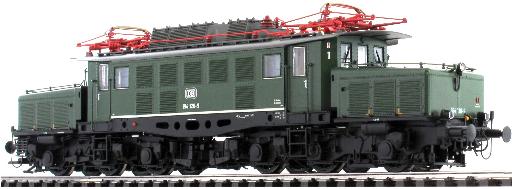
Piko 51860
DB BR118 Electric Locomotive
In the beginning of the 1930s, the DRG ordered new express train locomotives for the electrically powered railway networds in Germany. The E18s, delivered starting in 1935, were the fastest electric locomotives of the Deutsche Reichsbahn and reached a top speed of 150 km/hr (hence the blue livery: blue was reserved for locomotives whose top speed exceeded 140 km/hr, slower electric locomotives were painted green). In 1937 the E 18 22 won the Grand Prix in Paris for Speed and Performance. As of the beginning of WWII, 53 locomotives were put into operation. After the war, the Railway administrations of the Federal Republic of Germany (DB) and the German Democratic Republic (DRG) placed the remaining Express locomotives into service on their networks. In the Federal Republic of Germany, 41 E18 locomotives were in operation in the DB in the 1950s due to repurchases from the DDR and the construction of additional locomotives with available parts, and these were placed into operation in southern Germany. Until the arrival of the first standard Electric locomotives, these Express locomotives were the stars of the young DB. After 1957 they were displaced into Eilzug (fast train) service as well as Personenzug (local train) service. With its weight of almost 1200 tons, this powerful locomotive is referred to as Eisenschwein, or Iron Pig, in many German Bundesländer. The retirement of these elegant locomotives started in the middle of the 1970s and the last one was taken out of service by the DB in 1988, though some remained in service with the DR in East Germany until 1991 and with the ÖBB in Austria, with a stunning red livery, until 1995. These locomotives remain iconic darlings for German railway fans and a number of them have been preserved in Germany's railway museums. This beautiful model, which has sound and remote controlled pantographs (the pantos can be raised or lowered remotely), has running number 118 020-7, was part of the Nürnberg railway district, and its home locomotive depot was the BW (Bahnbetriebswerk) Würzburg.
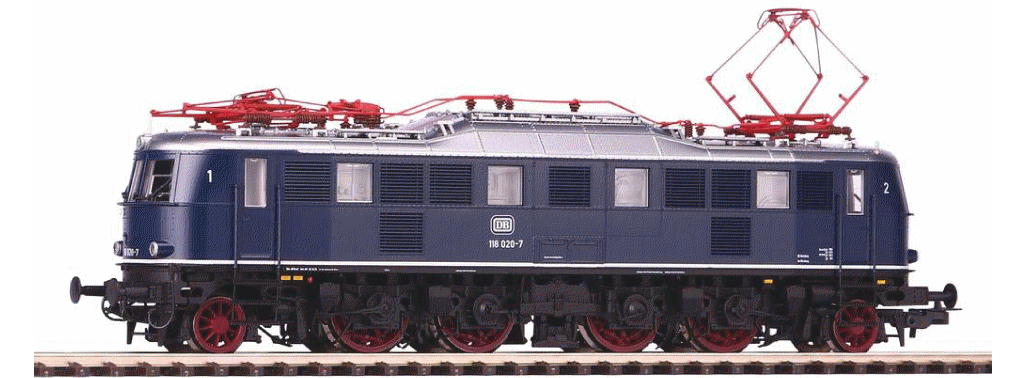
Fleischmann 407601
DB BR103 Electric Locomotive [outfitted for DCC with ESU LokPilot decoder]
The E103 or Class 103 (prototype series E 03) are heavy six-axled electric locomotives which were placed into fast passenger train service by the DB. Capable of delivering 10,116 hp, they were the most powerful locomotives in the world and were the DB's flagship locomotives for a very long time. A total of 4 E 03s and 145 E103s were built between 1968 and 1974. They were capable of 200 km/hr. but with custom modifications were able to reach peak speeds of 265 or even 280 km/hr. They were taken out of service in 2006, a sad day for railway enthusiasts for whom this is a revered locomotive. This model was reissued by Fleischmann in 2012 to celebrate its 125th anniversary.
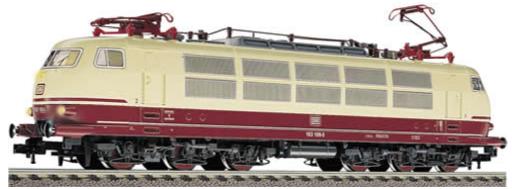
Roco 52540
DB BR144 Electric Locomotive [outfitted for DCC with ESU LokPilot decoder]
The Class 144 (E44) electric locomotives were the first electric locomotives on the German rail network. More than 100 units were put in service beginning in the 1930s. They were conceived as multipurpose locomotives for passenger and freight service, and as such were considered a pioneering achievement since until then most locomotives were dedicated exclusively to one or the other use. A total of 187 units were manufactured, predominantly between 1932 and 1945, and most of those units were put into service by the Deutsche Bundesbahn after WWII. Their maximum speed was 90 km/hr. The last units were taken out of service in 1991.
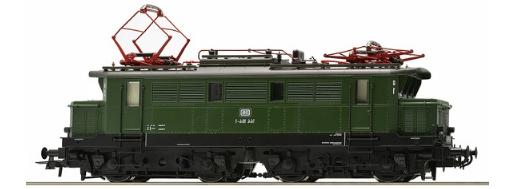
Fleischmann 1347
DB BR10 Electric Locomotive
This model was from 1967
The E10 or Class 110 was first put in service by the DB in 1952 for express train service. The German Federal Railroad decided in 1949 to build a more powerful general purpose locomotive to replace the aged class E 44 electric locomotive, a locomotive that could be used for heavy freight as well as passenger service. After a four year test period with five prototypes that were classed as the E 10.0 instead of E 46 as originally planned (due to the former’s maximum speed of 130 km/h / 81 mph), the decision was made to move away from the idea of a general purpose locomotive. Instead, emphasis was placed on the standardization of as many parts as possible in order to simplify construction and maintenance. A program of four types of locomotives for electric motive power was therefore put into place in which the class E 10 was an express locomotive only. The regular production version of the class E 10 had mechanical parts from Krauss-Maffei and electrical parts designed by SSW; Henschel, Krupp, AEG, BBC, and SSW had all built prototype locomotives and participated in the building of the regular production locomotives. Changes to the original concept were carried out again and again during the 12-year procurement period for these locomotives. They were equipped with headlights and marker lights in dual light bulb configurations, skirting under the streamlined buffers, and a continuous grillwork. Visually the most striking change was the aerodynamically improved ends to the locomotive introduced starting with locomotive E10 288; this new look was apparently given the affectionate nickname Bügelfalte (Pants Crease).They started to be taken out of service in 2000,though the last ones were retired in 2014. This model has a special place in my heart because it was given to me by my father for Christmas 1967 when I was eight years old and living in my mother's hometown of Landshut in Bavaria.
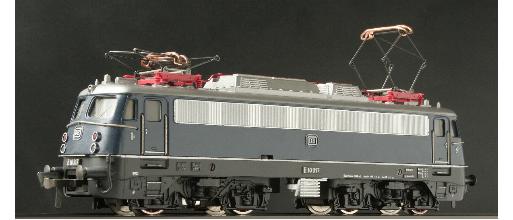
Fleischmann 4335
This is a later version of Fleischmann's DB BR10 Electric Locomotive from 1970 which has been outfitted with a Plux22 digital interface and a digital decoder.
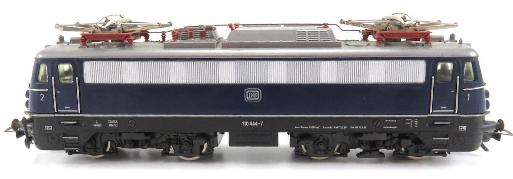
Fleischmann 4336
DB BR10 Electric Locomotive in TEE livery
The Trans Europ Express (TEE) network was set up in 1957 following an idea of F.Q. den Hollander, president-director at that time of the Dutch railway company (NS). It was a network jointly operated by the railways of West Germany (DB), France (SNCF), Switzerland (SBB-CFF-FFS), Italy (FS) and the Netherlands (NS). Although some trains operated through Belgium from the beginning, the national railway company (NMBS/SNCB) joined only in 1964. Luxembourg (CFL) also joined at a later date.
The idea was for a network of fast and comfortable international trains that would be attractive to businessmen and other regular travellers. All trains were first class only and required payment of a special supplement over the normal first-class ticket price, the amount of which depended on the distance covered. Where possible, TEE trains' schedules were timed to allow a business traveller to make a round trip within a single day and also have time for business activity at the destination. All the trains were expresses, stopping only at the main cities. The trains were named with wonderful names. Here are some notable ones:
Train
|
Route
|
Bacchus
|
Dortmund – Stuttgart – München
|
Bavaria
|
Zürich – München
|
Colosseum
|
Milano Centrale – Roma Termini
|
Erasmus
|
The Hague – München
|
Jules Verne
|
Paris Gare Montparnasse – Nantes
|
Molière
|
Köln – Paris Gare du Nord
|
Rembrandt
|
Amsterdam – Stuttgart
|
Rheingold (the most famous one)
|
Amsterdam – Geneva Cornavin
|
Settebello
|
Milano Centrale – Roma Termini
|
Van Beethoven
|
Amsterdam – Frankfurt (Main)
|

Jouef HJ2012
SNCF TGV Sud-Est [outfitted for DCC with ESU LokPilot decoder]
The TGV or Train à Grande Vitesse (meaning high-speed train) is France's high-speed rail service, operated by SNCF, the French national rail operator. The first version was the TGV Sud-Est, whose fleet was built by Alsthom between 1978 and 1988 and operated the first TGV service from Paris to Lyon in starting in 1981. The TGV Sud-Est was painted in orange livery and ran as a set with two power units (one on each end) and eight carriages with a capacity of 345 seats. Each power unit had two pantographs for overhead power pickup to accommodate the different voltages and line frequencies of the different countries where the TGV operated. Originally the sets were built to run at 270 km/hr. Most were upgraded to 300 km/h during mid-life refurbishment. The original orange livery has since been superseded by silver and blue. This set consists of two locomotives (one powered), one on each end, and two wagons in the middle.

Piko 57194 
DB ICE-3 [outfitted for DCC with ESU LokSound decoder]
The ICE-3 is Germany's third generation high speed train with a maximum speed of 330 km/h. The design goal of the ICE 3 (Class 403) was to create a higher-powered, lighter train than its predecessors. This was achieved by distributing its 16 traction motors underneath the whole train. The train is licensed for 330 km/h (210 mph) and has reached 368 km/h (228.66 mph)) on trial runs. On regular Intercity-Express services they run at up to 300 km/h (190 mph), the maximum design speed of German high-speed lines.
Because the train does not have powerheads, the whole length of the train is available for passenger seats, including the first car. The lounge-seats are located directly behind the driver, separated only by a glass wall.
The 50 sets were ordered in 1997 and specifically designed for the new high-speed line between Frankfurt and Cologne. They were built by a consortium led by Siemens and Adtranz (now Bombardier Transportation).
This set consists of two locomotives (one powered), one on each end, and two wagons in the middle, of which one is a restaurant car.

Source: Wikipedia.

|
|










